by Kristen Rasmussen
Enjoying food is similar to enjoying music—we have preferences from an early age, but by learning more about a longtime favorite or exploring a new genre, we can better understand and appreciate nuances and new styles. Cuisine is not one-note, but rather a combination of factors: the central baseline of chemicals that register taste, the chords and melodies determined by hundreds of aroma compounds, and the tangible percussion of texture and trigeminal effects, such as temperature and spice, all merge to create the songs of gastronomy. Like music, we all come to the table with culture and history that shape our experience and no one combination will work the same for every diner. Given this high potential for variation and the subjective nature of preference, how do we know what makes for a successful combination of ingredients?
In a previous article, Calibrating Flavour Part I: measuring the senses in a fast-paced world, I discussed the some of the challenges of sensory analysis and described a few innovative sense-measuring tools that are less time-intensive than the ‘gold standard’ evaluation process. Yet although these tools provide a valid overview of certain measurable characteristics such as similarity between samples, they do not get at the (IMHO) most important attribute when examining food—deliciousness, or shall we say in sensory terms, ‘hedonic value’. The study we conducted using these tools to investigate various aromatic spice blends showed us how compounds identified through chemical analysis translate to perceived flavour, but that is only part of the story. To get the full picture, or hear the full song, we need to understand how those blends of chemical and physical attributes inform preference, from a variety of different viewpoints.
One theory for why a cook or chef might want to use a certain combination of ingredients is the concept of ‘food pairing’. Food pairing hypothesises that ingredients sharing more flavour compounds are better suited for each other than those that share fewer flavour compounds. An obvious example of this concept would be garlic and onions, whereas tomato and parmesan or shrimp and white wine are less obvious examples of the pairing hypothesis, yet still intuitive. Even more extreme are the white chocolate and caviar or dark chocolate and blue cheese pairings that were introduced to menus specifically because of this food pairing theory and the discovery that these food duos shared a high number of flavour compounds (an impressive total of 73 for dark chocolate and blue cheese). This theory is so prevalent that it is a registered trademark and there is even a website dedicated to helping chefs and bartenders understand and use it.
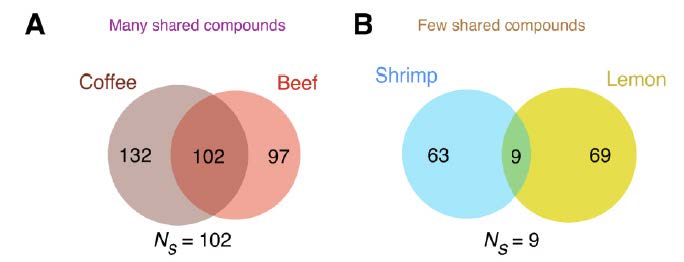

Food pairing is such a popular concept because it is relatively easy to understand but, fortunately or not, we humans and our desires are a bit more complex than this hypothesis alone can explain. Furthermore, it is difficult to quantify something with such an artistic element as gastronomy using so simple a formula. For a more complex view of the issue, one can look to the flavour network illustrated by Yong-Yeol Ahn and colleagues (2011). In their research, these Harvard scientists evaluated the shared flavour compounds in ingredients from over 50,000 recipes. What they found seemed to confirm the pairing hypothesis —a lot of ingredients having a high number of shared flavour compounds are in the same recipes, but it held only for Western European and Northern American recipes. For recipes hailing from Southern Europe and East Asia, it was the opposite story—foods are more likely to be paired with other foods if they have fewer flavour compounds in common, giving birth to the idea of ‘antipairing’.
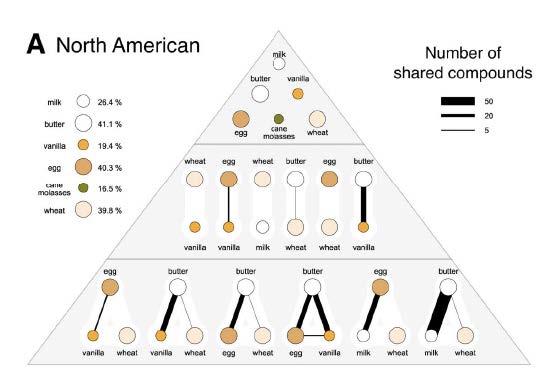
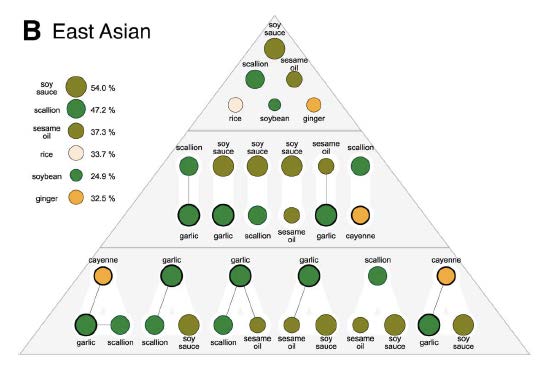
Figures 2 and 3. Example of how ingredients in North American recipes tend to share many compounds, whereas ingredients in East Asian recipes tend to share few compounds.
They go on to point out that these trends diminish significantly when the most characteristic ingredients of each cuisine are taken out of the equation. For example, when milk, wheat, and eggs are removed from North American recipes the resulting combinations demonstrate the food pairing hypothesis less robustly, and the same is true for anti-pairing of ginger, pork, and onion in East Asian recipes. At first glance, this observation supports the ‘flavour principle’, or the concept that the difference between traditional cuisines can be reduced a few ingredients (Rozin, 1973). However, if an observation is only true under the condition that the key ingredients in a recipe are removed, is it really worth noting, or is the recipe transformed beyond recognition and the observation rendered rather unuseful? I would also argue that the flavour principle itself is misguided because not only can a cuisine not be reduced to a set of ingredients, but a cuisine, its dishes, their variations, and an eater’s interaction with them, cannot be reduced to a set of factors—there is so much more at play. Consider the difference between consuming a meal in haste with a phone or computer nearby, and eating that same meal around a table in the company of others. Our daily companions and our broader culture not only determine what is considered acceptable as food, but also what is considered acceptable as the food environment—communal dining, conversation or no, sitting on chairs or on the floor or reclining, eating with cutlery or hands, take-out, and all manner of distractions.
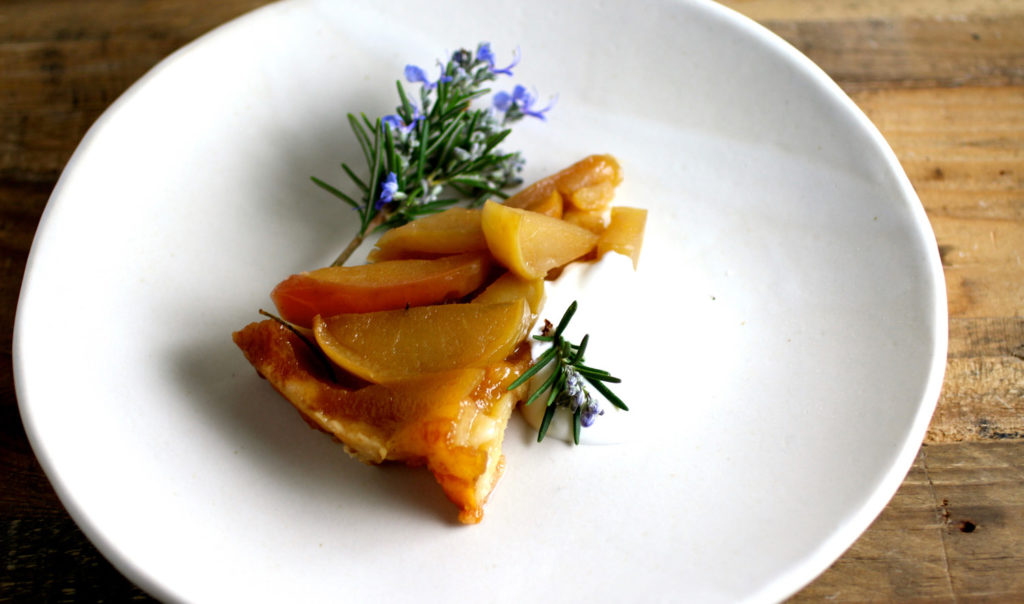
The food environment is just one factor beyond ingredient combinations that can not be ignored when exploring cuisine. Further important factors are, for example, culture, history, and relationship to innovation. By labeling certain cuisines with a formula for deliciousness—food pairing for Western Europe and North America and food anti-pairing for Southern Europe and East Asia—we are making assumptions that there is a correct way to create food in a given region. These assumptions make us more likely to disregard the diner’s background and context, and forget that norms and standards are constantly reorganising. Just like jazz, during its emergence, was (and in many cases continues to be) a musical revelation, recipes, menus, and new food genres do the same for the gastronomic world. These new ideas aren’t always good ones, and they often take some time to be iterated, refined, and accepted, but I believe it’s important to always keep trying rather than assume that the story is set in stone.
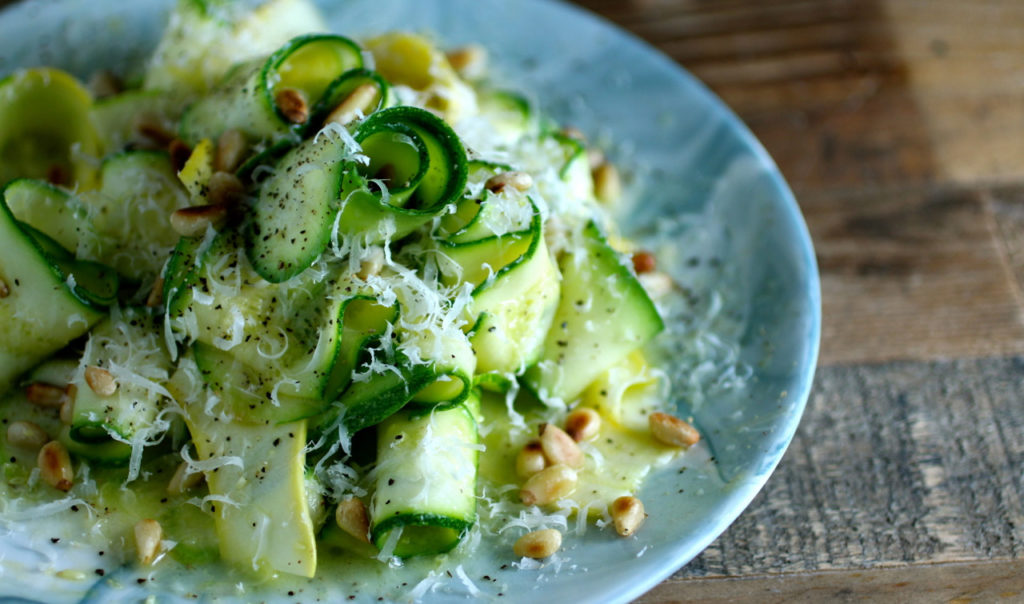
Another idea illustrated in the Ahn article on flavour networks is that all foods have a ‘fitness value’, which is determined by a combination of factors such as nutritional value, availability, antimicrobial properties, flavour, etc. In theory, foods are used because of their fitness value, which makes sense when you think about acidic ingredients like lemon or vinegar, that have a tartness to balance other flavours and create an inhospitable environment for “bad” bacteria. However, the elements of sensory and aesthetic preference that should be included as part of a food’s “fitness” are, as we have seen, difficult to quantify and evaluate. There are objective food fitness factors that make up part of the story, but there are also subjective factors without which the story makes no sense.
Determining the formula, or musical arrangement, for deliciousness is no easy task—probably because there is no one such arrangement in the first place. Foods do have certain measurable characteristics, but we also all taste food with a personal perspective—which is exactly what makes gastronomy fascinating for both the cook and the eater. Research investigating connections between flavour compounds and preference, such as those mentioned above, are vital to better understanding cuisine, but it is imperative to remember all the other factors that contribute to our eating experience, and, I would say, to never stop listening to new gastronomic music.
References
Ahn, et al. Flavour network and the principles of food pairing. Scientific Reports 1, Article number: 196 (2011).
Rozin, E. The flavor-principle cookbook. Hawthorn Books, Book Club Ed: 1973.
